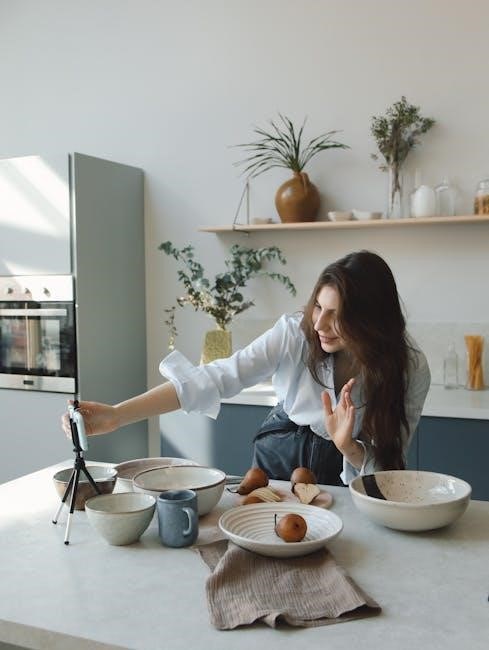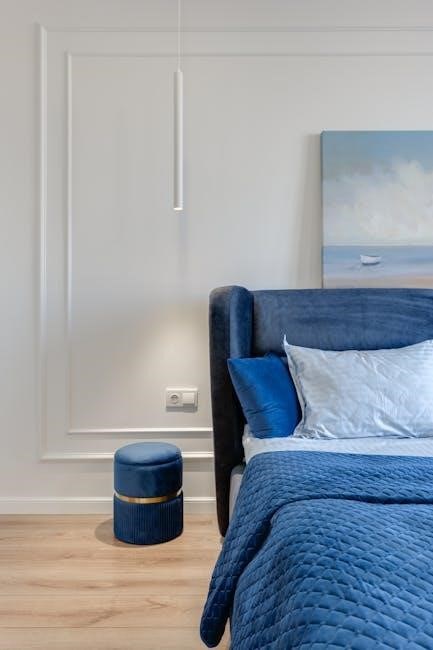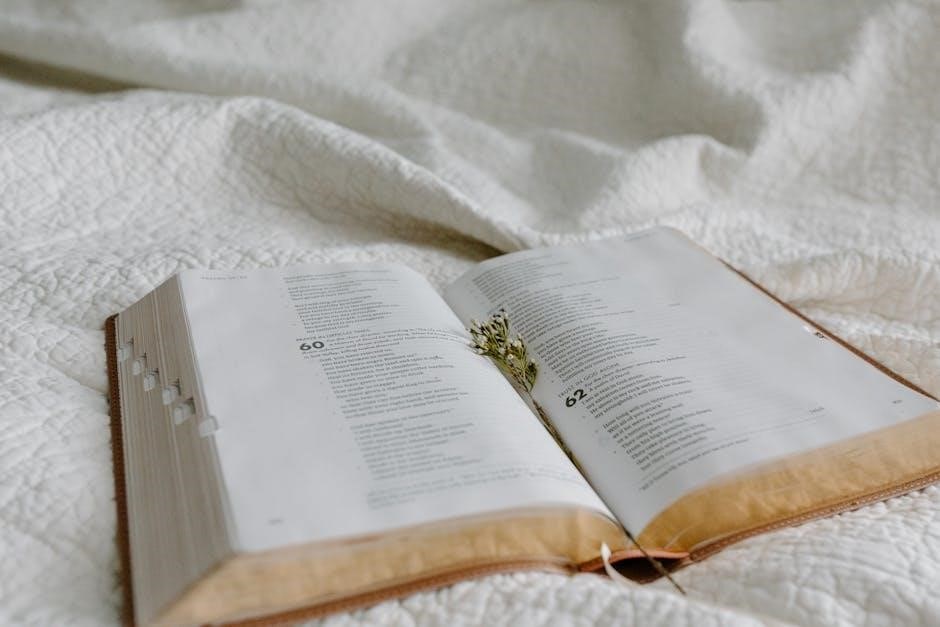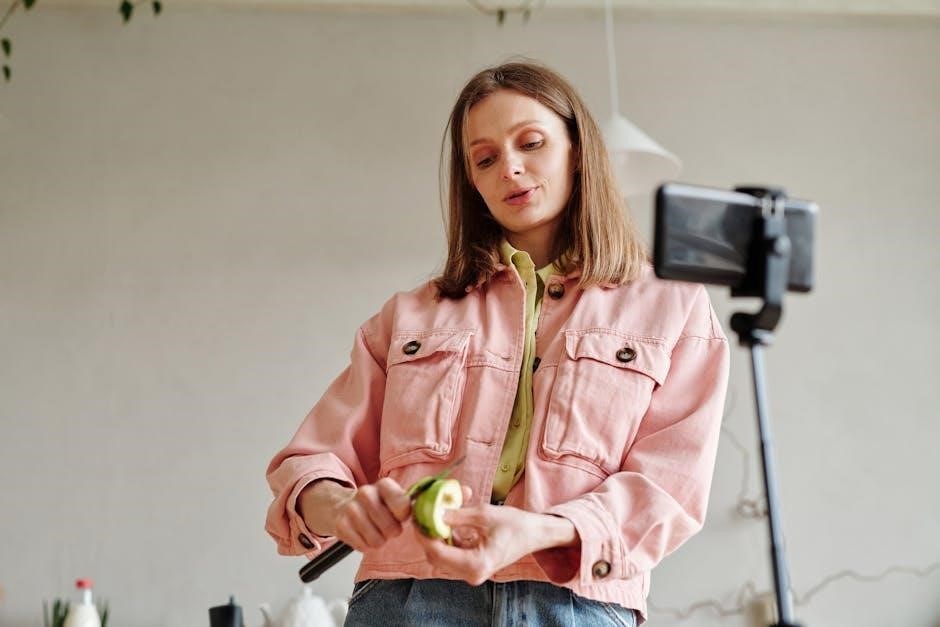Welcome to this crumb quilt tutorial! Discover how to transform fabric scraps into stunning quilts․ Perfect for crafty sewists, this method celebrates creativity, sustainability, and resourcefulness․
1․1 What is a Crumb Quilt?
A crumb quilt is a unique and eco-friendly project made from small fabric scraps․ These quilts celebrate creativity by transforming leftover pieces into vibrant, one-of-a-kind designs․ Unlike traditional quilts, crumb quilts embrace imperfection, offering a playful way to use up every last bit of fabric․ They are perfect for crafty sewists who enjoy experimenting with colors, textures, and patterns․ Each crumb quilt tells a story, as the scraps often come from past projects, giving the finished piece a personal touch․ This method is not only sustainable but also rewarding, turning would-be waste into something truly special․ Learn how to create your own crumb quilt with this step-by-step guide․
1․2 Benefits of Using Scraps for Quilting
Using fabric scraps for quilting offers numerous benefits․ It’s an eco-friendly way to reduce waste, giving leftover materials a new life․ Quilting with scraps is cost-effective, as it utilizes fabric you already have․ This method also fosters creativity, encouraging experimentation with colors and patterns․ Scraps allow for unique, one-of-a-kind designs that reflect your personal style․ Additionally, working with small pieces can improve sewing skills and patience․ The process is rewarding, as it transforms discarded fabric into something beautiful and functional․ This approach is perfect for crafters who enjoy sustainability and the satisfaction of creating something meaningful from scraps․

1․3 Why Crumb Quilting is Popular
Crumb quilting has gained popularity due to its versatility and creative appeal․ Crafters love transforming small fabric scraps into unique quilts, reducing waste and showcasing their ingenuity․ The process is therapeutic, allowing quilters to experiment with colors and patterns․ It’s also budget-friendly, as it utilizes leftover fabric․ Additionally, crumb quilting fosters a sense of accomplishment by turning discarded materials into something beautiful․ The technique is accessible to all skill levels, making it a favorite among both beginners and experienced quilters․ Its growing community and inspiring projects further fuel its popularity in the quilting world․

Gathering Materials and Supplies
Gather essential tools like a sewing machine, rotary cutter, and mat․ Collect fabric scraps, thread, and batting․ Organize materials to streamline the crumb quilting process creatively․
2․1 Essential Tools for Crumb Quilting
To begin crumb quilting, you’ll need a few essential tools․ A rotary cutter and mat are crucial for accurately cutting fabric scraps․ A sewing machine is necessary for piecing blocks, while sharp scissors come in handy for trimming small pieces․ A ruler ensures straight cuts, and iron and ironing board are vital for pressing seams․ Additional supplies include thread, batting, and binding fabric․ Organizing tools like storage bins or small containers help keep scraps tidy․ These tools will help you efficiently create your crumb quilt project from start to finish․
2․2 Fabric Requirements and Scrap Organization
For crumb quilting, fabric requirements are flexible, as the technique thrives on using small scraps․ Sort scraps by color, size, and type to streamline the process․ Aim for a variety of fabrics to add visual interest․ Estimate fabric needs based on the quilt size and number of crumb blocks desired․ Organize scraps in bins or containers for easy access․ Consider pre-cutting scraps into uniform sizes for consistency․ Using a mix of patterns and solids ensures a dynamic design․ Proper scrap organization ensures efficiency and creativity when piecing your crumb quilt․

Step-by-Step Crumb Quilt Tutorial
Discover how to create a crumb quilt through a simple, step-by-step process․ Learn to sort, piece, and press crumb blocks efficiently for a unique, scrap-friendly project․
3․1 Sorting and Preparing Fabric Scraps
Sorting and preparing fabric scraps is the foundation of crumb quilting․ Begin by organizing scraps by color, pattern, and size․ Use small pieces to create diverse blocks․ Iron and trim scraps to remove selvages and imperfections․ Consider sorting scraps into piles based on their intended use in the quilt․ Grouping similar fabrics ensures a cohesive look․ Preparing scraps in advance saves time during piecing․ Keep scraps in labeled bins for easy access․ This step sets the stage for creating unique, visually appealing crumb blocks․
3․2 Piecing Crumb Blocks: A Beginner’s Guide

Piecing crumb blocks is a fun and creative process․ Start by sewing small fabric scraps together, using a simple strip-piecing technique․ Arrange scraps randomly or in a coordinated color scheme․ Use a 1/4-inch seam allowance and press seams as you go․ Begin with a foundation square or strip, then add pieces incrementally․ This method allows for endless design possibilities․ Don’t worry about perfect matches—crumb blocks celebrate imperfection․ As you sew, the blocks will grow, forming unique, patchwork designs․ This step is all about experimentation and enjoying the journey of transforming scraps into something beautiful․
3․3 Pressing and Squaring Crumb Blocks
Pressing and squaring crumb blocks are essential steps for a professional finish․ After piecing, press seams flat with a hot iron, using steam if needed, to ensure crisp folds․ Trim excess fabric around the block to create a uniform shape․ Most crumb blocks are squared to 6․5 inches, but you can adjust based on your quilt design․ Use a rotary cutter and mat for precise trimming․ This step ensures all blocks fit seamlessly together, maintaining a cohesive look․ Proper pressing and squaring are key to achieving a polished, professional crumb quilt finish․

Combining Crumb Blocks into a Quilt
Arrange crumb blocks in a layout that suits your design, then sew them together, adding sashing if desired for a cohesive, professional-looking quilt finish․
4․1 Designing the Quilt Layout
Designing the quilt layout is where creativity shines! Arrange crumb blocks in a pattern that balances color, texture, and visual interest․ Consider a random scatter, organized grid, or themed design․ Use a design wall to experiment with placements, ensuring harmony and flow․ Vary block sizes and orientations for dynamism․ Neutral sashing or borders can enhance cohesion․ Personalize the layout to reflect your style, whether modern, traditional, or eclectic․ This step transforms individual blocks into a unified masterpiece, making each quilt truly unique and meaningful․

4․2 Sewing Blocks Together and Adding Sashing
Once your crumb blocks are pressed and squared, it’s time to sew them together․ Align blocks carefully, ensuring seams match for a cohesive look․ Sew blocks in rows or columns, pressing seams as you go․ For added structure, add sashing between blocks—narrow strips of fabric that separate and frame the crumb blocks․ Choose sashing fabric that complements the quilt’s color palette․ Add cornerstones where sashing meets to enhance visual balance․ This step transforms individual blocks into a unified quilt top, ready for layering and quilting․ Proper alignment and consistent seam allowances are key for a polished finish․

Finishing the Quilt
Complete your crumb quilt by layering the top with batting and backing, then quilting the layers together․ Finally, bind the edges for a professional finish․
5․1 Layering and Quilting the Layers
Layering and quilting are crucial steps in completing your crumb quilt․ Begin by laying out the quilt backing, followed by batting, and finally the crumb quilt top․ Smooth out any wrinkles to ensure even layers․ Use pins or spray adhesive to secure the layers together․ Choose a quilting pattern that complements the crumb design, such as straight lines, free-motion, or stippling․ Stitch carefully, ensuring even tension to avoid puckering․ Trim excess batting and backing fabric after quilting․ This step brings your crumb quilt to life, transforming it into a cohesive and beautiful piece of handmade art․
5․2 Binding the Quilt for a Professional Finish
Binding is the final step to complete your crumb quilt, adding a decorative edge and protecting the seams․ Cut binding strips from coordinating fabric, either bias or straight, depending on your preference․ Sew the strips together diagonally to create a continuous length․ Attach the binding to the quilt edges, aligning raw edges and folding at corners for a neat fit․ Fold the binding over and hand-stitch or machine-sew in place․ Mitered corners add a polished touch․ This step ensures a clean, professional finish, sealing your crumb quilt with style and durability․

Tips and Variations
Explore creative ways to enhance your crumb quilt, such as adding embellishments or experimenting with layouts․ Use leftover crumbs for small projects like coasters or pillow covers․
6․1 Using Leftover Crumbs for Other Projects
Transform leftover crumbs into meaningful creations! Use small fabric scraps to make coasters, hot pads, or even stuffing for DIY pillows․ These projects are perfect for using up every last bit of fabric․ You can also piece together crumb squares to create unique zipper pouches or decorative patches․ Additionally, consider sewing crumb blocks into a quilted table runner or baby blanket․ This approach not only reduces waste but also adds a personal touch to everyday items․ Get creative and turn your crumbs into something truly special, keeping your sewing space organized and your fabric stash under control․
6․2 Troubleshooting Common Issues
Encounter uneven seams? Adjust your seam allowance for consistency․ Struggling with misaligned blocks? Use pins to guide fabric placement and press thoroughly․ Fabric scraps too small? Combine with complementary solids or patterns․ Blocks not matching? Square them precisely before sewing․ Running low on crumbs? Supplement with leftover strips or small cuts․ Colors clashing? Use a unifying sashing or border․ For wavy edges, starch fabric before sewing․ Don’t let setbacks discourage you—every challenge is an opportunity to refine your skills and make your crumb quilt uniquely yours!
Creating a crumb quilt is a rewarding journey that celebrates creativity and sustainability․ Thank you for joining this tutorial—happy quilting and enjoy your unique masterpiece!
7․1 The Joy of Creating a Crumb Quilt
Creating a crumb quilt is a deeply rewarding experience that sparks creativity and satisfaction․ Working with small fabric scraps allows you to experiment with colors and patterns, transforming discarded pieces into something truly unique․ Each crumb block tells a story, making the quilt a personal and meaningful project․ The process fosters a sense of accomplishment as you witness your scraps evolve into a beautiful, functional piece of art․ It’s a celebration of resourcefulness and imagination, offering joy in both the crafting journey and the finished product․

7․2 Encouragement to Start Your Crumb Quilt Journey
Embrace the creative journey of crumb quilting and transform scraps into something truly special․ This technique is perfect for crafty sewists who love experimenting with colors and patterns․ By turning leftover fabrics into unique blocks, you not only reduce waste but also create a meaningful, one-of-a-kind quilt․ Don’t be afraid to start small—every crumb block is a step toward something beautiful․ Whether you’re a seasoned quilter or a beginner, this process is a celebration of creativity and resourcefulness․ Dive in, enjoy the process, and watch your fabric scraps come to life in a stunning crumb quilt․